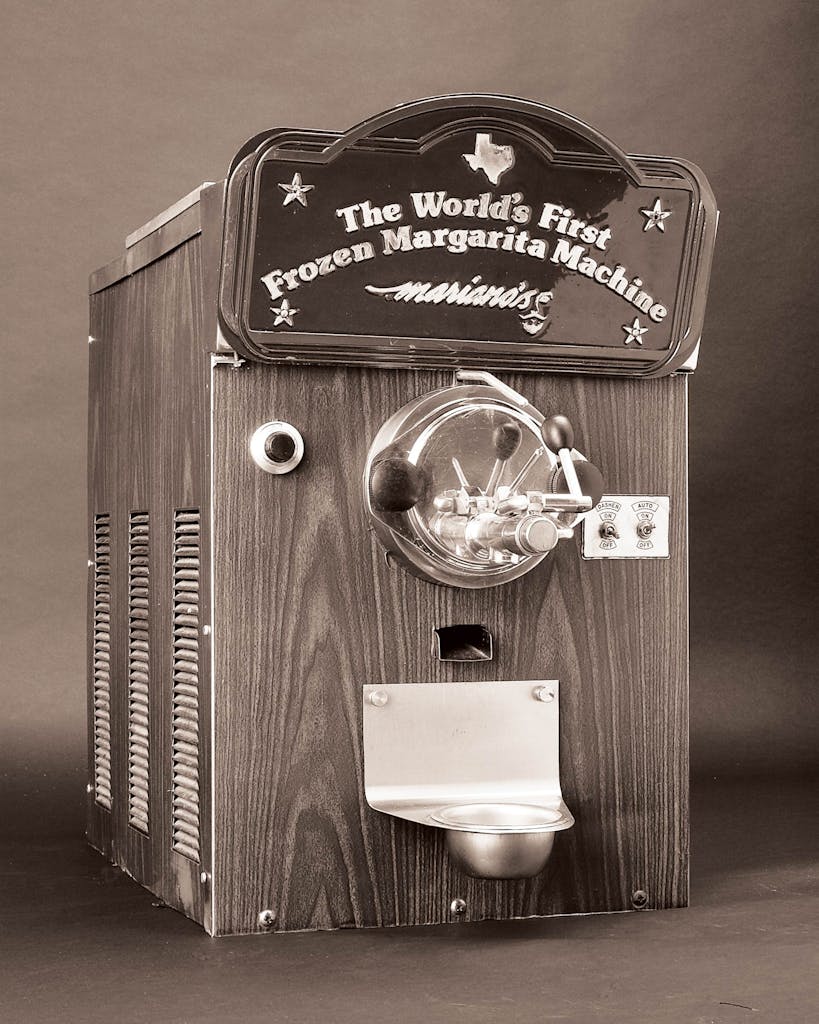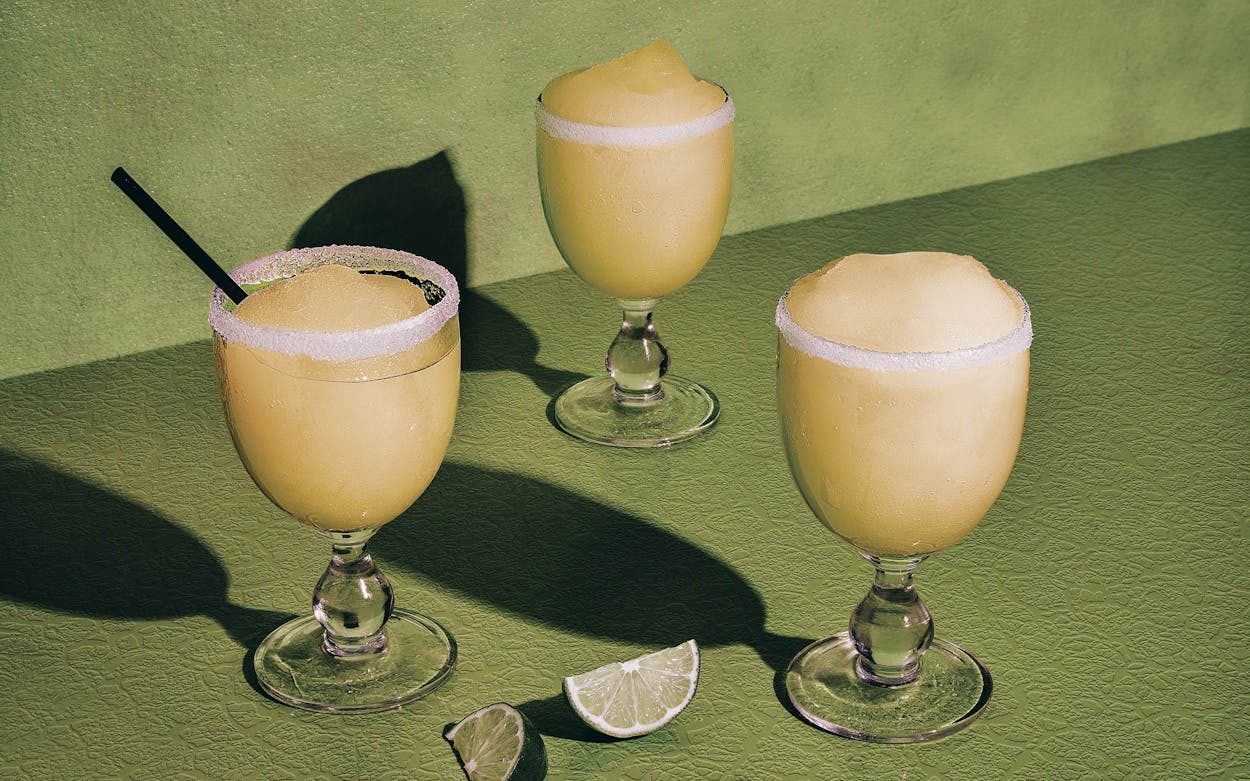In the cantina the cocktail servers were adjusting their sequined miniskirts, while waitresses in black lace-up vests, gaucho pants, and tall boots chatted and laughed in the simulated moonlight of the dining room. A gregarious young man named Mariano Martinez rushed around in white leather bell-bottoms, setting out bottles of tequila and fresh limes. The date was May 7, 1971, and it was opening night of the much-anticipated Mariano’s Mexican Cuisine, in the tony Old Town shopping center of Dallas. At five o’clock, the doors swung open, and the crowd surged in and immediately started ordering frozen margaritas. In less than two hours, everything had gone straight to hell.
It wasn’t that everyone was drunk, but it did have to do with the margaritas. The first round was great, but pretty soon the bartenders were so backlogged they just started throwing ingredients in the blenders. No two drinks were alike, and everybody was complaining. One worker snapped at Martinez, “I’ve got cramps in my hands from squeezing those damn limes. I’m going back to Steak and Ale, where all they want is bourbon and Coke.” The 26-year-old proprietor was terrified, imagining his reputation going down the drain along with gallons of lousy margaritas.
Martinez, now 76, takes up the story he has recounted with gusto for five decades. “I tossed and turned all that night,” he says. “The next morning I went to 7-Eleven for coffee and a pack of gum.” While there, he glanced at the store’s Slurpee machine, and “it came to me in a flash, like a gift from God.” If that thing could make a slushy soft drink, surely it could make a frozen margarita. When the Southland Corporation, the parent company of 7-Eleven at the time, declined to sell him one, he and a mechanically minded friend named Frank Adams bought a used SaniServ soft-serve ice cream machine and lugged it to the restaurant. “We tinkered around with it,” he remembers; they installed a stronger motor and compressor to swirl and chill the ingredients, and then Martinez experimented with different amounts of tequila, orange liqueur, and fresh lime juice. A few days later, on May 11, as they were setting the industrial-looking apparatus on the bar, he recalled a bit of advice from his friend Norman Brinker, the brains behind Chili’s. The restaurant guru had cautioned that people wouldn’t pay much for a drink made by a machine. He’d also warned him not to destroy the mood. So Martinez covered the shiny stainless-steel box with wood-grain contact paper. The icy green slush that would soon emerge from it was about to make cocktail history.

Born in Dallas in 1944, Martinez grew up in a family with deep roots in the Mexican restaurant business. His mother, Vera, was related to the Cuellar family, which founded the Dallas-based El Chico chain, in 1940. She worked as an administrative manager in the office of the Oak Lawn location, and his father, Mariano, put in eighty hours a week managing the upscale Lakewood-area restaurant.
In mid-century Texas, business and social success often depended on assimilation into the Anglo community. “The year before I started school,” Martinez says, “we spoke only English at home, and my mother took my sister and me to Sanger’s, sometimes even Neiman’s, to buy clothes.” They had a good life—a happy life—in spite of overt racism in Dallas, especially at school. In the sixth grade, Martinez recalls, “this white kid knocked me down, we started fighting, and he called me an ‘effing Mexican.’ ” In high school, he says, “I would have one date with an Anglo girl, but then she’d say, ‘My father said I can’t go out with you again because you’re Mexican.’ ” He hated school, with the exception of a single lesson, on inventors: “I remember vividly the day we learned about Thomas Edison and the Wright brothers. Afterward I thought, ‘Oh, man, that’s what I want to be.’ ” A famous Einstein quote became his mantra: “Imagination is more important than knowledge.”
When he dropped out in tenth grade, the principal said to his mother, who had reluctantly given her permission, “You’re making a big mistake. He’s going to end up in jail. You will rue this day.” Vera left the office in tears, but Martinez remembers thinking, “I’ll show him.” For a few years he lived in the fast lane, playing and singing in a band (thus the white leather bell-bottoms) and hoping for a music career. He had fun and made plenty of money, but he hedged his bets by getting a GED and a liberal arts degree from El Centro (now Dallas) College. When reality finally caught up with him, he took out a Small Business Administration loan, asked his grandmother for recipes, and turned to something he knew really well: the Mexican food business.

Slush Fun
A seven-ounce frozen margarita was $1.25 at Mariano’s in 1971. Nowadays Martinez’s best-seller by far is a $14 margarita made with Don Julio reposado, Cointreau, and fresh lime juice. Its name is the Mariano, and it’s on the rocks.
As it happened, 1971 was an excellent time to open a restaurant. More and more women were taking jobs outside the home, and families were dining out more often. Mexican immigrants, who provided the workforce for many of these new restaurants, were bringing recipes for then-exotic stuff like ceviche and mole poblano, adding to the state’s beloved Tex-Mex repertoire of crispy tacos and cheese enchiladas. A fajita craze took hold and spread across the state, thanks in large part to “Mama” Ninfa Laurenzo’s tacos al carbón. Most importantly, in April of 1971, Texas legalized selling liquor by the drink in restaurants. No longer did diners have to tote bottles of booze to the table just to enjoy a cocktail.
Martinez was in the right place at the right time. A savvy media observer, he never passed up a chance to talk about his machine (at one point he had eleven of them at a single restaurant). When customers said, “You should have patented that thing—you’d be a billionaire!” he would smile and nod. Privately, he had his doubts. “It would have been about as ridiculous as putting two carburetors in a ’57 Chevy, painting on some flames, and trying to patent it.” Still, he was aware that he had kick-started a movement that was changing the restaurant industry. Not only had he helped take tequila from hooch to haute, he’d also invented something that would have a profound effect on the way people consume cocktails, from piña coladas to frozen daiquiris and everything in between.
Twenty years and an ocean of frozen margaritas later, Martinez retired the sturdy original contraption to a place of honor in one of his restaurants. He was quite fond of the thing, but he didn’t think about it often; he was focused on building a Dallas-area group of new restaurants. Then, in 2003, he received an unusual solicitation. The Smithsonian Institution wanted to know if he’d consider donating that first machine to the National Museum of American History, in Washington, D.C. “I wasn’t surprised,” he says. He agreed, of course, and a curator, Dallas-born Rayna Green, got busy. She researched the patent history of frozen drink makers, checked rival claims, and verified decades-old newspaper accounts. Her conclusion: His truly was the world’s first frozen margarita machine. The honor “was beyond my dreams,” Martinez says. When the day came to ship the machine, though, he was conspicuously absent. “I didn’t go into work that day because I didn’t want to see it leave the building,” he says quietly.
Martinez’s five restaurants keep him busy these days, though he lets his staff, some of whom have been with him for thirty years, handle day-to-day operations. As for his modest little box, still covered in wood-grain contact paper, it sits on permanent display not far from Julia Child’s kitchen. On the museum’s website is a statement declaring that it stands at “the crossroads of a revolution” heralding the rise of regional Mexican food across America. To Martinez, though, it also represents a personal triumph. “It wasn’t just a machine to me,” he says. In some ways, “I’m still that little Mexican kid that got beat up in the sixth grade. It validated me, and that means a lot.”
This article originally appeared in the May 2021 issue of Texas Monthly with the headline “In the Limelight.” Subscribe today.
- More About:
- Libations
- Margaritas
- Dallas









